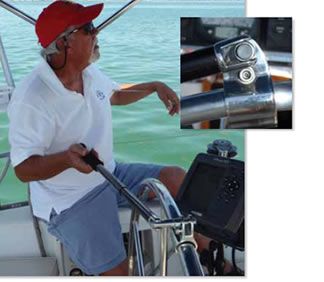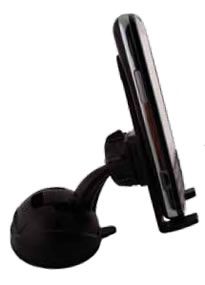
324
Forespar, a California-based marine hardware and accessories manufacturer, recently launched a product that takes relaxed summer sailing to a whole new level. Designed to be used while motoring or in fair sailing conditions, the Steering Arm Control is like a tiller extension for steering wheels. It allows the helmsman to kick back on a stern-mounted seat or move out to the rail and still maintain control of the helm.
The steering stick’s telescoping arm has a quick-release, stainless-steel attachment clamp at the wheel end. The clamp is secured with one hex-head screw (hex wrench included); testers found it easy and fast to mount to the wheel.
Our initial concern was that the arm would get hung up on the wheel, cockpit seats, cockpit well sides, binnacle, etc., if it were dropped in a hurry during an emergency maneuver. The quick-release design eased those concerns—users simply push the release pin’s button, and the arm pops off the mount—but we’d still recommend using the Steering Arm Control only when the conditions are light and easy. According to Forespar, the product “should not be used when tacking, jibbing, or in rough or adverse conditions.”
PS testers recently took the $140 wheel tiller for a spin on a Tartan 37, sailing Sarasota Bay, Fla., in 8 knots of breeze and no chop. (The product is designed more for use on bigger boats or those with stern seats, but we don’t have any in our test-boat fleet.) Once the attachment clamp was secured, it took the skipper a minute or two to re-adjust to tiller-steering thinking. Once he got his groove back, he found that the device allowed for fingertip-steering and maintained excellent control. The extension’s length could easily be adjusted as the helmsman moved around, and his new-found mobility offered more options for seats with prime forward visibility and comfort. Perched on the rail, he could easily see around the large genny.
The wheel tiller lived up to maker’s claims. The price is a bit of a deterrent, but it’s worth checking out if you’ve felt chained to the wheel and have been eying your the stern seat as the place to enjoy a relaxing summer ride.

324
Having sprung for a Droid-based smart phone, we began poking around for accessories to take cruising.
The favorite was the Cobra universal mini-mount ($25). This non-permanent mount uses what Cobra calls Ever-Last Breakaway Adhesive to keep the phone and mount in place. The phone swivels on a lockable ball-and-socket joint, so you can view it from different angles. We’ve moved it from car to boat multiple times now, and the mount has lost some of its stickiness—a trade-off for portability—but still works. RAM (www.ram-mount.com) has some more-permanent options.

Our search for weather apps landed on a handy little weather radar app: Raindar. This free application available at the Android Market (https://market.android.com/) uses Google Earth and radar images from Weather Underground to create timely, animated Doppler radar images of approaching storms. The app proved handy during our summer cruise in storm-prone Florida waters, making it easier to see how fast summer squalls were approaching.
When the rain finally came, we wrapped our phone in RingerWraps (www.cleverwraps.com), clear Ziplock-syle baggies available in a range of sizes ($10 for five wraps). Not meant for full immersion, the wrap kept our phone dry in a heavy downpour. Unfortunately, the seal at the back of the RingerWrap made it impossible to stick the phone on our mini-mount. A sandwich bag, though less pretty, did the trick.

324

Over the years, we have suffered the proverbial slings and arrows of standard toolboxes onboard: gelcoat and varnish dings, scrapes, scratches, dents, scuffs, and the occasional rust-stained reminder that rigid tool boxes are not ideal for use aboard boats. Throw in the difficulties of stowage and transportation (both on your boat and during that dinghy ride to help a fellow sailor), and you have even more incentive to find a better solution.
Although soft toolbags solve some of the problems associated with hard cases, they have their own downside, primarily a lack of tool organization. This is especially true with larger bags, which tend to have a crater-like center compartment that ensures whatever tool you need is always hidden somewhere at the bottom.
During a recent discussion of onboard tool-stowage options, one PS tester recalled a backpack-style toolkit he used while working as an electronics technician with the U.S. Coast Guard. It combined great tool organization with hands-free transportation. We discovered that the maker, Paktek Inc., was still in business, so we decided to check out its ToolPak model 90650, a soft-sided tool organizer that is advertised as more marine-friendly than metal toolboxes and easier to carry and stow than plastic ones.
Constructed of 1000-denier nylon, the ToolPak has six zippered sections with more than 100 tool holders and pockets. The padded shoulder straps are adjustable and feature utility loops, and the padded handles make it easy to carry a loaded pack. The company touts the exterior as being water-resistant.
Testers found the pack’s construction to be excellent, and after loading it up with the contents of three smaller canvas toolbags, we found that it lived up to its claims of better tool organization, portability, and stowage. Another feature we liked was the ability to customize the tool holders by removing the vertical stitching between smaller pockets to make a large pocket.
One area of concern, in our opinion, is the pack’s metal zippers, which tend to corrode and break in short order when the live in a marine environment. The ToolPak’s zippers do appear to be of good quality, but as is the case with any shipboard zipper, owners will want to keep them free of dirt, salt, and grime, and apply a lubricant for smoother operation, etc.

The ToolPak retails for $100 and is guaranteed to be free of defects in workmanship and materials for one year.
Compared to the last toolbag we reviewed—the $80 reversible Original Nantucket Diddy Bag (www.nantucketbagg.com) in the October 2008 issue—the ToolPak is a little more expensive, but it offers triple the storage pockets and boasts better organization and hands-free portability. If you find yourself often lugging toolboxes back and forth from boat to shore, or neighboring boats, we recommend giving the ToolPak a try.







































